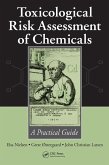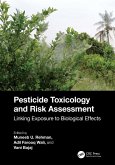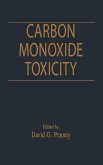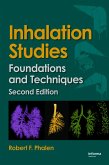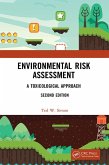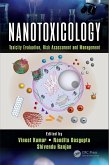Environmental Toxicity of Nanomaterials (eBook, PDF)
Redaktion: Kumar, Vineet; Ranjan, Shivendu; Dasgupta, Nandita
213,95 €
213,95 €
inkl. MwSt.
Sofort per Download lieferbar

107 °P sammeln
213,95 €
Als Download kaufen

213,95 €
inkl. MwSt.
Sofort per Download lieferbar

107 °P sammeln
Jetzt verschenken
Alle Infos zum eBook verschenken
213,95 €
inkl. MwSt.
Sofort per Download lieferbar
Alle Infos zum eBook verschenken

107 °P sammeln
Environmental Toxicity of Nanomaterials (eBook, PDF)
Redaktion: Kumar, Vineet; Ranjan, Shivendu; Dasgupta, Nandita
- Format: PDF
- Merkliste
- Auf die Merkliste
- Bewerten Bewerten
- Teilen
- Produkt teilen
- Produkterinnerung
- Produkterinnerung

Bitte loggen Sie sich zunächst in Ihr Kundenkonto ein oder registrieren Sie sich bei
bücher.de, um das eBook-Abo tolino select nutzen zu können.
Hier können Sie sich einloggen
Hier können Sie sich einloggen
Sie sind bereits eingeloggt. Klicken Sie auf 2. tolino select Abo, um fortzufahren.

Bitte loggen Sie sich zunächst in Ihr Kundenkonto ein oder registrieren Sie sich bei bücher.de, um das eBook-Abo tolino select nutzen zu können.
This book focuses on causes and prevention of environmental toxicity induced by various nanomaterials. It describes the basic principles, trends, challenges and future directions of nanoecotoxicity, and factors affecting toxicity of nanomaterials, various studies in nanoecotoxicity evaluation, and the safety and risk assessment of nanomaterials.
- Geräte: PC
- mit Kopierschutz
- eBook Hilfe
- Größe: 18.85MB
Andere Kunden interessierten sich auch für
![Mixture Toxicity (eBook, PDF) Mixture Toxicity (eBook, PDF)]() Mixture Toxicity (eBook, PDF)38,95 €
Mixture Toxicity (eBook, PDF)38,95 €![Toxicological Risk Assessment of Chemicals (eBook, PDF) Toxicological Risk Assessment of Chemicals (eBook, PDF)]() Elsa NielsenToxicological Risk Assessment of Chemicals (eBook, PDF)187,95 €
Elsa NielsenToxicological Risk Assessment of Chemicals (eBook, PDF)187,95 €![Pesticide Toxicology and Risk Assessment (eBook, PDF) Pesticide Toxicology and Risk Assessment (eBook, PDF)]() Pesticide Toxicology and Risk Assessment (eBook, PDF)188,95 €
Pesticide Toxicology and Risk Assessment (eBook, PDF)188,95 €![Carbon Monoxide Toxicity (eBook, PDF) Carbon Monoxide Toxicity (eBook, PDF)]() Carbon Monoxide Toxicity (eBook, PDF)64,95 €
Carbon Monoxide Toxicity (eBook, PDF)64,95 €![Inhalation Studies (eBook, PDF) Inhalation Studies (eBook, PDF)]() Robert F. PhalenInhalation Studies (eBook, PDF)187,95 €
Robert F. PhalenInhalation Studies (eBook, PDF)187,95 €![Environmental Risk Assessment (eBook, PDF) Environmental Risk Assessment (eBook, PDF)]() Ted SimonEnvironmental Risk Assessment (eBook, PDF)192,95 €
Ted SimonEnvironmental Risk Assessment (eBook, PDF)192,95 €![Nanotoxicology (eBook, PDF) Nanotoxicology (eBook, PDF)]() Nanotoxicology (eBook, PDF)229,95 €
Nanotoxicology (eBook, PDF)229,95 €-
-
-
This book focuses on causes and prevention of environmental toxicity induced by various nanomaterials. It describes the basic principles, trends, challenges and future directions of nanoecotoxicity, and factors affecting toxicity of nanomaterials, various studies in nanoecotoxicity evaluation, and the safety and risk assessment of nanomaterials.
Hinweis: Dieser Artikel kann nur an eine deutsche Lieferadresse ausgeliefert werden.
Dieser Download kann aus rechtlichen Gründen nur mit Rechnungsadresse in A, B, BG, CY, CZ, D, DK, EW, E, FIN, F, GR, HR, H, IRL, I, LT, L, LR, M, NL, PL, P, R, S, SLO, SK ausgeliefert werden.
Hinweis: Dieser Artikel kann nur an eine deutsche Lieferadresse ausgeliefert werden.
Produktdetails
- Produktdetails
- Verlag: Taylor & Francis eBooks
- Seitenzahl: 537
- Erscheinungstermin: 17. April 2018
- Englisch
- ISBN-13: 9781351252959
- Artikelnr.: 54109701
- Verlag: Taylor & Francis eBooks
- Seitenzahl: 537
- Erscheinungstermin: 17. April 2018
- Englisch
- ISBN-13: 9781351252959
- Artikelnr.: 54109701
- Herstellerkennzeichnung Die Herstellerinformationen sind derzeit nicht verfügbar.
Iqrar Ahmad Khan with long career in education and agriculture had earned PhD from the University of California, Riverside. He is currently serving as Vice Chancellor of the University of Agriculture, Faisalabad, Pakistan (since 2008). Dr. Khan has supervised more than 100 graduate students and researchers, established a Center of Agricultural Biotechnology and co-founded a DAAD sponsored 'International Center for Decent Work and Development' (ICDD), USAID funded Center of Advanced Studies in Agriculture and Food Security, a French Learning Center and the Chinese Confucius Institute. He has organized numerous international conferences and established academic linkages across the continents. He has released a potato variety (PARS-70), pioneered research on breeding seedless Kinnow and discovered new botanical varieties of wheat. Dr. Khan initiated an internationally acclaimed program to solve a devastating problem called Witches' Broom Disease of Lime in Oman. He is currently leading international projects to combat citrus greening disease and mango sudden death. He has published more than 270 articles, five books and several book chapters. Dr. Khan has a diplomatic skill to attract international partnerships and academic linkages (Afghanistan, Australia, South Korea, China, Germany, France, Malaysia, Indonesia, Turkey, Iran, India, Oman, Canada, UK and USA). He has managed collaborative research projects sponsored by national and international agencies. As Vice Chancellor, he has revamped UAF academic, research and outreach programs. He added new academic disciplines to narrow the knowledge gaps in microbiology, biotechnology, environmental sciences, food and nutrition, climate change, engineering, rural development and education. UAF has achieved top ranks within the national system as well as in the QS and NTU rankings. Dr. Khan has a special knack for problem solving research. He has set up an Incubation Center for the commercialization of knowledge. Exhibitions and business plan competitions have been made biannual features. A range of new quality assurance mechanisms have been added and special initiatives are taken to narrow the gender gap. Dr. Khan is a Fellow of Pakistan Academy of Sciences and member of several professional societies and associations. In recognition of his outstanding contributions in the area of Agriculture and Food Security he was decorated with a civil award, Sitara-e-Imtiaz by the Government of Pakistan and very recently with Ordre des Palmes Académiques (with the grade of Officer) by the French Government for his exceptional role as an educator.
1. Toxic Effects of Nanomaterials on Environment 2. Nanotoxicity: Impact on
Health and Environment 3. Nanotoxicological Evaluation in Marine Water
Ecosystem: A Detailed Review 4. Interaction of Carbon Nanomaterials with
Biological Matrices 5. Interaction of Inorganic Nanoparticles with
Biological Matrices 6. Effects of Engineered Nanoparticles on Bacteria 7.
Comparative Risk Assessment of Copper Nanoparticles with Their Bulk
Counterpart in the Indian Major Carp Labeo rohita 8. Toxic Effects of
Nanomaterials to Plants and Beneficial Soil Bacteria 9. Nanotoxicity of
Silver Nanoparticles: From Environmental Spill to Effects on Organisms 10.
Nanotoxicity on Human and Plant Pathogenic Microbes and Aquatic Organisms
11. Methods of In Vitro and In Vivo Nanotoxicity Evaluation in Plants 12.
In Vitro and In Vivo Nanotoxicity Evaluation in Plants 13. Phytochemicals
and Their Functionalized Nanoparticles as Quorum Sensing Inhibitor and
Chemotherapeutic Agent 14. Nanotoxicological Evaluation in Freshwater
Organisms 15. Guidelines and Protocols for Nanotoxicity Evaluation 16.
Regulations for Safety Assessment of Nanomaterials
Health and Environment 3. Nanotoxicological Evaluation in Marine Water
Ecosystem: A Detailed Review 4. Interaction of Carbon Nanomaterials with
Biological Matrices 5. Interaction of Inorganic Nanoparticles with
Biological Matrices 6. Effects of Engineered Nanoparticles on Bacteria 7.
Comparative Risk Assessment of Copper Nanoparticles with Their Bulk
Counterpart in the Indian Major Carp Labeo rohita 8. Toxic Effects of
Nanomaterials to Plants and Beneficial Soil Bacteria 9. Nanotoxicity of
Silver Nanoparticles: From Environmental Spill to Effects on Organisms 10.
Nanotoxicity on Human and Plant Pathogenic Microbes and Aquatic Organisms
11. Methods of In Vitro and In Vivo Nanotoxicity Evaluation in Plants 12.
In Vitro and In Vivo Nanotoxicity Evaluation in Plants 13. Phytochemicals
and Their Functionalized Nanoparticles as Quorum Sensing Inhibitor and
Chemotherapeutic Agent 14. Nanotoxicological Evaluation in Freshwater
Organisms 15. Guidelines and Protocols for Nanotoxicity Evaluation 16.
Regulations for Safety Assessment of Nanomaterials
1. Toxic Effects of Nanomaterials on Environment 2. Nanotoxicity: Impact on
Health and Environment 3. Nanotoxicological Evaluation in Marine Water
Ecosystem: A Detailed Review 4. Interaction of Carbon Nanomaterials with
Biological Matrices 5. Interaction of Inorganic Nanoparticles with
Biological Matrices 6. Effects of Engineered Nanoparticles on Bacteria 7.
Comparative Risk Assessment of Copper Nanoparticles with Their Bulk
Counterpart in the Indian Major Carp Labeo rohita 8. Toxic Effects of
Nanomaterials to Plants and Beneficial Soil Bacteria 9. Nanotoxicity of
Silver Nanoparticles: From Environmental Spill to Effects on Organisms 10.
Nanotoxicity on Human and Plant Pathogenic Microbes and Aquatic Organisms
11. Methods of In Vitro and In Vivo Nanotoxicity Evaluation in Plants 12.
In Vitro and In Vivo Nanotoxicity Evaluation in Plants 13. Phytochemicals
and Their Functionalized Nanoparticles as Quorum Sensing Inhibitor and
Chemotherapeutic Agent 14. Nanotoxicological Evaluation in Freshwater
Organisms 15. Guidelines and Protocols for Nanotoxicity Evaluation 16.
Regulations for Safety Assessment of Nanomaterials
Health and Environment 3. Nanotoxicological Evaluation in Marine Water
Ecosystem: A Detailed Review 4. Interaction of Carbon Nanomaterials with
Biological Matrices 5. Interaction of Inorganic Nanoparticles with
Biological Matrices 6. Effects of Engineered Nanoparticles on Bacteria 7.
Comparative Risk Assessment of Copper Nanoparticles with Their Bulk
Counterpart in the Indian Major Carp Labeo rohita 8. Toxic Effects of
Nanomaterials to Plants and Beneficial Soil Bacteria 9. Nanotoxicity of
Silver Nanoparticles: From Environmental Spill to Effects on Organisms 10.
Nanotoxicity on Human and Plant Pathogenic Microbes and Aquatic Organisms
11. Methods of In Vitro and In Vivo Nanotoxicity Evaluation in Plants 12.
In Vitro and In Vivo Nanotoxicity Evaluation in Plants 13. Phytochemicals
and Their Functionalized Nanoparticles as Quorum Sensing Inhibitor and
Chemotherapeutic Agent 14. Nanotoxicological Evaluation in Freshwater
Organisms 15. Guidelines and Protocols for Nanotoxicity Evaluation 16.
Regulations for Safety Assessment of Nanomaterials


